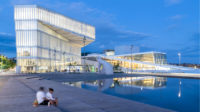Diamond Schmitt Architects
St. Petersburg, Russia
After a decade of hotly contested design and construction, conductor Valery Gergiev's opera house thrills audiences amid ongoing discord.
| Photo by Tim Griffith |
Almost any route through St. Petersburg leads among florid palazzos, their pastel plumage reflected in quiet canals. Founded almost exactly 300 years ago, the city's core is pretty much complete, so it's surprising that one new architectural extravaganza, the 2,000-seat Mariinsky II opera house by Toronto-based Diamond Schmitt Architects, should be so ostentatiously neutral (RECORD, April 2013, page 21). On first encounter you notice only its stolid bulk, that great gray hunk of limestone lurking behind the mint-colored old Mariinsky. At dusk, the eye flits to the relic of a lemon-yellow Neoclassical facade affixed to one flank, then takes in the building's glowing glass hat, and continues through the glass curtain wall to the spectacle inside. There Swarovski crystals drip from the ceiling. A suspended steel staircase ribbons through the atrium like an orange peel. Between acts, patrons bask in the flattering glow from the luminescent wall of polished onyx that wraps the auditorium. The gloss is nice, but this is Russia, and that's kid stuff in the bling department.
This intrusion of soft-core modernism in the heart of the imperial city is troubling, and not just because new buildings here are too rare to waste. Everything about the opera house's architecture is tentative–even the attempt to be self-effacing–yet it's been assigned a formidable role. Russian president Vladimir Putin, whose government footed the $700 million bill, was the first to appear on the stage, neatly tying together the futures of the Mariinsky and Russian opera with that of the nation itself. St. Petersburg has hitched its global brand to culture. Opera and ballet are not elite pleasures but a wellspring of the city's identity. Valery Gergiev, the company's artistic and general director since 1996, is a celebrity of billboard stature, and the new house is the product of his dream.
“How do you like the new Mariinsky?” locals ask with wrinkled noses. “More comfortable but less spirit, no?”
Yes.
To understand why the city needed a second Mariinsky, it helps to visit the ornate original and sit sweltering, 10 rows back from the front of the czar's box, trying to get a glimpse of a hilariously awful production of Verdi's Nabucco. Ushers fill the aisles with back-ravaging chairs, the narrow lobby looks as if it hasn't been touched since Soviet days, and most of the entrances are blocked by metal gates. Opened in 1860, this was the aristocracy's warm lair, where the elite could be entertained at leisure. In Anna Karenina, Count Vronsky attends the Mariinsky and spends his time twisting around to scan the audience from his regular front-row seat. The czar's box contained only a handful of seats then; the rest of the space was for dining, napping, and cards.
Under Gergiev, the Mariinsky company–once named for the Soviet general Kirov–has fostered a more serious and egalitarian approach. Performances are ceaseless and popular, and Gergiev himself is ubiquitous on virtually every continent. If there were a concert hall at the South Pole, he would show up. Just hours after bringing the curtain down on the three-day opening festival, he and the orchestra boarded a private train for Moscow, the first leg of an annual tour of sprawling hinterland cities and small Siberian towns. There's something touching about these missionaries of high culture leaving their shiny new home and going off to pack whatever rundown auditorium they find, sometimes giving three concerts in a single day.
Mariinsky II embodies the ambition to perform more works more often, for more people–which is why Gergiev insists that what matters is not how it looks but how it sounds and what it can do. It's certainly impressively equipped. Six separate stages–one at the proscenium, one in the rear, and four in the wings–roll into various configurations like tiles in a numbers puzzle, making it possible to switch sets, or even operas, in minutes. These platforms can be raised by a giant hydraulic lift or isolated by soundproof partitions, so that an orchestra can record a symphony while an opera performance is taking place a few feet away. With its gently swooping balconies and paneling of blond-beech slats, the auditorium has all the quirkiness of a Scandinavian convention center, but its sightlines are superb and the sound is clear and light. At intermission, audiences have plenty of space to mingle, including a rooftop terrace with views onto a skyline flecked with golden spires. Perhaps most important to Russian habits is the ample cloakroom. (Try entering any restaurant, museum, or concert hall in St. Petersburg with an outer garment slung over your arm, and you will be firmly commanded to check it.)
Gergiev has some justification for believing it is the music that imbues a hall with spirit. In 2006, the Mariinsky carved a smallish, 1,200-seat concert space out of a burned-out warehouse. It's not a handsome place–low-ceilinged lobbies spill into disorienting hallways, and the auditorium is lined with plywood blocks–but even the most staid program attracts a young and excitable crowd. One 10 p.m. concert started more than half an hour late, with an ecstatic performance of the Brahms Violin Concerto by Leonidas Kavakos, whose liquid lyricism somehow fused with the orchestra's wild, seat-of-the-pants explosiveness. After three more concertos, the audience kept cheering until 1:30 a.m.
That enthusiasm carried into the new house, too. During the rollout's festive chaos, bewildered ushers led audience members astray, numbered seats were inexplicably removed, a large wall panel clattered to the floor, and toilets worked sporadically. Still, nobody who heard the soprano Anna Netrebko's desperately sensual Iolanta, or saw Diana Vishneva dance Maurice Béjart's 50-year-old but still smoldering Bolero, was thinking much about architecture.
Even if the kinks work themselves out, and the Mariinsky magically develops an aesthetic to match its sophisticated technology, the new building will still be a missed opportunity. An opera house has a role to play in the cityscape, too, and this one seems lost. The company originally commissioned a bravura design by Dominique Perrault, a great gilded barnacle that competed with St. Petersburg's glinting domes. Popular outrage over the design, stoked by out-of-control costs, killed that plan after construction had already begun, and the company retreated to a stance of ruthless practicality. Gergiev could surely have found an architect who not only had experience in the technical demands of opera but was also able to translate rococo sensibility into modern exuberance–someone at home with color, texture, and drama. Instead, the maestro accepted a fallacy he would never tolerate in his orchestra: that the alternative to bombast is banal good taste.
New York










